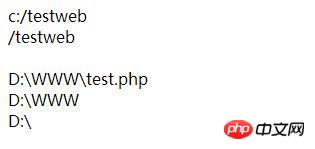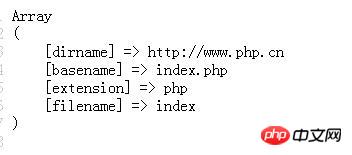 Backend Development
Backend Development
 PHP Tutorial
PHP Tutorial
 Differences and examples of dirname, basename, pathinfo functions in php
Differences and examples of dirname, basename, pathinfo functions in php
Differences and examples of dirname, basename, pathinfo functions in php
To get the path, directory or file name of a file in php, we often use dirname(), basename(), pathinfo() These three functions have been introduced separately in the previous article. This article mainly introduces to you in detail
The differences and usage examples of these three functions.
dirname() function
string dirname ( string $path )
php dirname function gets the directory part of the given file path , the parameter $path is a string of file paths
dirname() function is often used with the magic variable __FILE__, which represents the full path and file name of the currently running file.
dirname(dirname(__FILE__)); What you get is the name of the directory above the file
dirname(__FILE__); What you get is the name of the directory where the file is located
For example:
<?php
echo dirname("c:/testweb/home.php")."<br/>";
echo dirname("/testweb/home.php")."<br/><br/>";
echo __FILE__ ."<br/>";
echo dirname(__FILE__)."<br/>";
echo dirname(dirname(__FILE__));
?>Code running result:

##basename() function
string basename ( string $path [, string $suffix ] )
The example is as follows:
<?php
var_dump(basename("/etc/sudoers.d", ".d"));
var_dump(basename("/etc/passwd"));
var_dump(basename("/etc/"));
var_dump(basename("."));
var_dump(basename("/"));
?>Code running result:

pathinfo() function
php The pathinfo function is used to parse the path and parse the path into an array. The array includes the directory name, complete file name, file extension and file name (excluding the file suffix), and the key names of these four values are dirname, basename, extension and filename respectively. We can use these four key names to obtain the values of the directory name, complete file name, file extension and file name. Syntax:mixed pathinfo ( string $path [, int $options = PATHINFO_DIRNAME | PATHINFO_BASENAME | PATHINFO_EXTENSION | PATHINFO_FILENAME ] )
Parameters: path The path to parse. options If specified, the specified elements will be returned; they include: PATHINFO_DIRNAME, PATHINFO_BASENAME and PATHINFO_EXTENSION or PATHINFO_FILENAME. If options are not specified, the default is to return all units.
Example:
<?
$test = pathinfo("http://localhost/index.php");
print_r($test);
?> Code running result:

The above is the detailed content of Differences and examples of dirname, basename, pathinfo functions in php. For more information, please follow other related articles on the PHP Chinese website!

Hot AI Tools

Undresser.AI Undress
AI-powered app for creating realistic nude photos

AI Clothes Remover
Online AI tool for removing clothes from photos.

Undress AI Tool
Undress images for free

Clothoff.io
AI clothes remover

Video Face Swap
Swap faces in any video effortlessly with our completely free AI face swap tool!

Hot Article

Hot Tools

Notepad++7.3.1
Easy-to-use and free code editor

SublimeText3 Chinese version
Chinese version, very easy to use

Zend Studio 13.0.1
Powerful PHP integrated development environment

Dreamweaver CS6
Visual web development tools

SublimeText3 Mac version
God-level code editing software (SublimeText3)

Hot Topics
 1387
1387
 52
52
 Alipay PHP SDK transfer error: How to solve the problem of 'Cannot declare class SignData'?
Apr 01, 2025 am 07:21 AM
Alipay PHP SDK transfer error: How to solve the problem of 'Cannot declare class SignData'?
Apr 01, 2025 am 07:21 AM
Alipay PHP...
 Explain JSON Web Tokens (JWT) and their use case in PHP APIs.
Apr 05, 2025 am 12:04 AM
Explain JSON Web Tokens (JWT) and their use case in PHP APIs.
Apr 05, 2025 am 12:04 AM
JWT is an open standard based on JSON, used to securely transmit information between parties, mainly for identity authentication and information exchange. 1. JWT consists of three parts: Header, Payload and Signature. 2. The working principle of JWT includes three steps: generating JWT, verifying JWT and parsing Payload. 3. When using JWT for authentication in PHP, JWT can be generated and verified, and user role and permission information can be included in advanced usage. 4. Common errors include signature verification failure, token expiration, and payload oversized. Debugging skills include using debugging tools and logging. 5. Performance optimization and best practices include using appropriate signature algorithms, setting validity periods reasonably,
 Explain the concept of late static binding in PHP.
Mar 21, 2025 pm 01:33 PM
Explain the concept of late static binding in PHP.
Mar 21, 2025 pm 01:33 PM
Article discusses late static binding (LSB) in PHP, introduced in PHP 5.3, allowing runtime resolution of static method calls for more flexible inheritance.Main issue: LSB vs. traditional polymorphism; LSB's practical applications and potential perfo
 How does session hijacking work and how can you mitigate it in PHP?
Apr 06, 2025 am 12:02 AM
How does session hijacking work and how can you mitigate it in PHP?
Apr 06, 2025 am 12:02 AM
Session hijacking can be achieved through the following steps: 1. Obtain the session ID, 2. Use the session ID, 3. Keep the session active. The methods to prevent session hijacking in PHP include: 1. Use the session_regenerate_id() function to regenerate the session ID, 2. Store session data through the database, 3. Ensure that all session data is transmitted through HTTPS.
 Describe the SOLID principles and how they apply to PHP development.
Apr 03, 2025 am 12:04 AM
Describe the SOLID principles and how they apply to PHP development.
Apr 03, 2025 am 12:04 AM
The application of SOLID principle in PHP development includes: 1. Single responsibility principle (SRP): Each class is responsible for only one function. 2. Open and close principle (OCP): Changes are achieved through extension rather than modification. 3. Lisch's Substitution Principle (LSP): Subclasses can replace base classes without affecting program accuracy. 4. Interface isolation principle (ISP): Use fine-grained interfaces to avoid dependencies and unused methods. 5. Dependency inversion principle (DIP): High and low-level modules rely on abstraction and are implemented through dependency injection.
 How to automatically set permissions of unixsocket after system restart?
Mar 31, 2025 pm 11:54 PM
How to automatically set permissions of unixsocket after system restart?
Mar 31, 2025 pm 11:54 PM
How to automatically set the permissions of unixsocket after the system restarts. Every time the system restarts, we need to execute the following command to modify the permissions of unixsocket: sudo...
 Explain late static binding in PHP (static::).
Apr 03, 2025 am 12:04 AM
Explain late static binding in PHP (static::).
Apr 03, 2025 am 12:04 AM
Static binding (static::) implements late static binding (LSB) in PHP, allowing calling classes to be referenced in static contexts rather than defining classes. 1) The parsing process is performed at runtime, 2) Look up the call class in the inheritance relationship, 3) It may bring performance overhead.
 How to debug CLI mode in PHPStorm?
Apr 01, 2025 pm 02:57 PM
How to debug CLI mode in PHPStorm?
Apr 01, 2025 pm 02:57 PM
How to debug CLI mode in PHPStorm? When developing with PHPStorm, sometimes we need to debug PHP in command line interface (CLI) mode...



